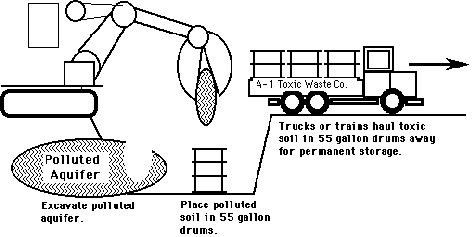Excavation & Storage
Excavation & storage is a successfully used method for
cleaning up toxic waste. This method involves digging up an removing the poison
from the aquifer, and hauling this to an area where the materials can be safely
stored for posterity. The storage part would be similar to what they do with
nuclear waste. Essentially the waste is placed into special 55 gallon drums,
and then stored (preferably in desert areas) on dry surfaces which have plastic
tarp or concrete under them to collect any toxic materials that leak out.
If nothing is done to treat the toxic wastes so they are made harmless, then
they must be stored and guarded for eternity to prevent their leaking out
again!

Cost: about $14 million/ or about $240
extra on the tax bill over 10 years.
Pros
1. This method ensures that most or all of the pollutants are
removed from the ground.
2. Any water that flows through this ground in the future will
be cleaner.
3. If the polluted area is small and not too deep, then the
area can be cleaned up in a short time.
Cons
1. Buildings, streets, lakes, etc. may have to be dug up and
destroyed in order to find the pollution.
2. Because of the digging and need for large equipment, there
will be a lot of noise & dust in the neighborhood. Some of the dust could
contain toxic chemicals.
3. Accidents may happen to workers (cave ins may occur).
4. Possibility of vehicular accidents while transporting wastes
to storage sites.
5. Stored wastes may leak over time if not properly cared for.
6. Toxic waste problem becomes someone elses problem.
Links
Links about using stored toxic wastes to make fertilizer!:
GHS Biology
Pollution Cleanup Options Menu
Paul Slichter